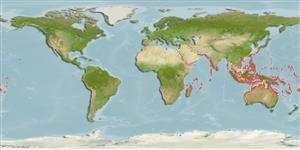Common names from other countries
Environment: milieu / climate zone / depth range / distribution range
Écologie
marin récifal; profondeur 0 - 80 m (Ref. 9773). Tropical; 32°N - 34°S, 27°E - 170°W
Indo-Pacific: East Africa and eastward through northern Australia to Samoa; north to southern Japan. Replaced by closely related Sufflamen albicaudatus in the Red Sea (Ref. 37816).
Taille / Poids / Âge
Maturity: Lm ? range ? - ? cm
Max length : 30.0 cm TL mâle / non sexé; (Ref. 30573)
Épines dorsales (Total): 3; Rayons mous dorsaux (Total): 26-28; Épines anales 0; Rayons mous anaux: 23 - 26. Juveniles dark brown above, white below (Ref. 1602). Adult variable in color; the bar running through the pectoral base can either be yellow or black, and some individuals may be largely yellowish posteriorly (Ref. 1602).
Inhabit coastal to outer reefs. Habitats from silty lagoons to pristine outer reef walls (Ref. 48637). Occur in shallow lagoon and seaward reefs. Solitary and territorial. Feed on a wide variety of invertebrates. Also taken by drive-in nets (Ref. 9770). Oviparous (Ref. 205). Monogamous (Ref. 52884). Minimum depth reported taken from Ref. 128797.
Life cycle and mating behavior
Maturité | Reproduction | Frai | Œufs | Fécondité | Larves
Male defends a defined territory, within which a female resides. On the day prior to spawning, female pushes her snout into the sandy bottom repeatedly and removes small stones and pieces of coral at several sites. Adhesive eggs are deposited on the sandy bottoms or in a small cavity of the reef covered with sand. Female fans the eggs and defends the nest, while male patrols around female (Ref. 8603). Females are territorial, solely tending and guarding the eggs (Ref. 116451). Males exhibit polygyny (Ref. 116451).
Myers, R.F., 1991. Micronesian reef fishes. Second Ed. Coral Graphics, Barrigada, Guam. 298 p. (Ref. 1602)
Statut dans la liste rouge de l'IUCN (Ref. 130435)
CITES (Ref. 128078)
Not Evaluated
Menace pour l'homme
Harmless
Utilisations par l'homme
Pêcheries: intérêt commercial mineur; Aquarium: Commercial
Plus d'informations
RéférencesAquacultureProfil d'aquacultureSouchesGénétiqueElectrophoresesHéritabilitéPathologiesTraitementMass conversion
Outils
Articles particuliers
Télécharger en XML
Sources Internet
Estimates based on models
Preferred temperature (Ref.
115969): 24.8 - 29.3, mean 28.4 (based on 3050 cells).
Phylogenetic diversity index (Ref.
82804): PD
50 = 0.5312 [Uniqueness, from 0.5 = low to 2.0 = high].
Bayesian length-weight: a=0.02042 (0.01188 - 0.03509), b=2.94 (2.79 - 3.09), in cm Total Length, based on LWR estimates for this species & (Sub)family-body (Ref.
93245).
Niveau trophique (Ref.
69278): 3.8 ±0.20 se; based on food items.
Résilience (Ref.
120179): Milieu, temps minimum de doublement de population : 1,4 à 4,4 années (Preliminary K or Fecundity.).
Fishing Vulnerability (Ref.
59153): Low vulnerability (20 of 100).
